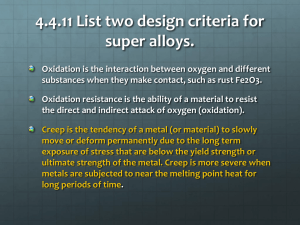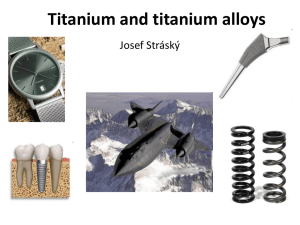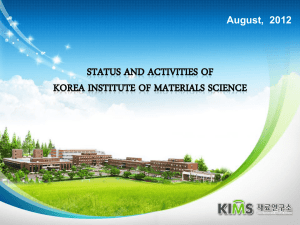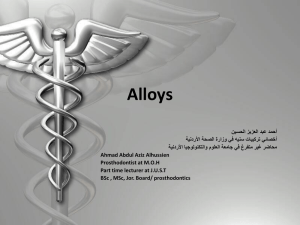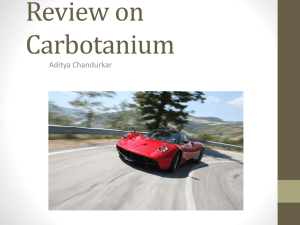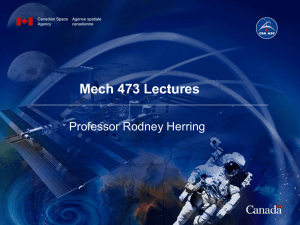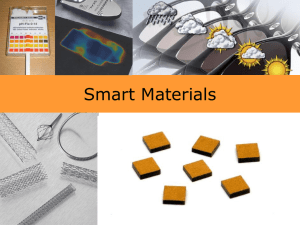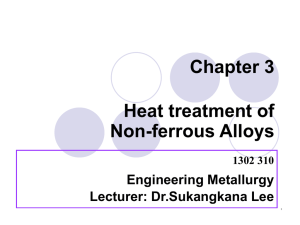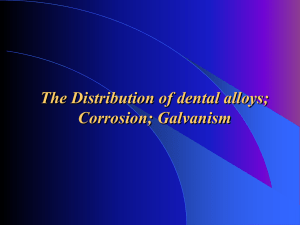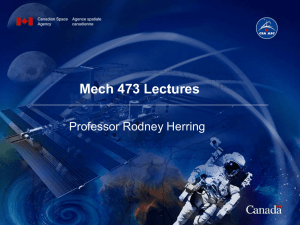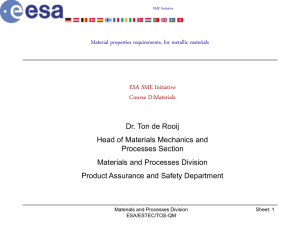Titanium and titanium alloys
advertisement
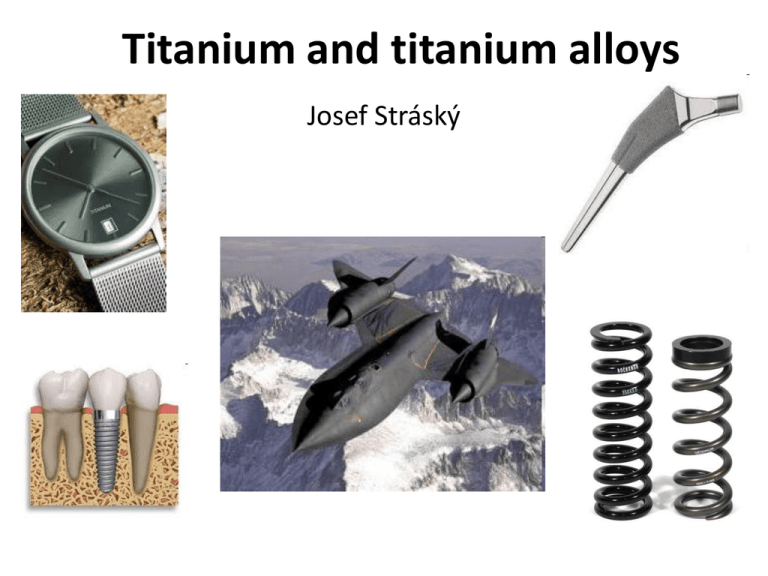
Titanium and titanium alloys Josef Stráský Lecture 3: Technological aspects of Ti alloys • Pure Ti – metallurgy, properties and applications • α+β alloys • microstructures, metallurgy, heat treatment • Ti-6Al-4V alloy properties and applications • High temperature alloys • Metastable β-alloys • Metallurgy, heat treatment • High strength alloys Pure titanium and a - alloys • After cooling a – phase only • Alloys contain Al and Sn, interstitial O, C, N and only limited amount of b-stabilizers • Comparatively low strength (pure Ti) • Pure Ti – strengthened by interstitial O • a – alloys strengthen also via substitutional strengthening and precipitates (Ti3Al) Pure Ti – grade 1 - 4 • Commercial purity – CP Ti is manufactured with four different oxygen contents (grade 1- 4) • Oxygen content is decisive for strength of the material • CP Ti is cheaper than Ti alloys • Corrosion resistance is the key advantage when compared other classes of materials • Corrosion resistance can be further increased by small content of Pd or Ru (0.05 -0.2 %) O [wt.%] Fe (max.) [wt.%] s02 [MPa] CP Ti Grade 1 0.18 0.2 170 CP Ti Grade 2 0.25 0.3 275 CP Ti Grade 3 0.35 0.3 380 CP Ti Grade 4 0.40 0.5 480 Grade Pure Ti - applications • Chemical and petrochemical industry, power plants – Resistant to aggressive chemicals – Heat exchangers, pipes,… • Pressure vessels – Can be used over wide range of temperatures and pressures – Chemically resistant • Cryogenic vessels – Storage of liquid oxygen and hydrogen • used in space-shuttles – lighter than steel Pure Ti – biomedical use • Non-toxic inert material • Pure Ti can be used only for implants without extensive demands for strength, otherwise stronger alloys must be used – Some small orthopaedic fixation implants – Dental implants (stents) – current use of ultra-fine grained CP Ti a + b - alloys • After cooling mixture of a and b phases • The original and still the most common high-strength Ti alloys • Three different types of microstructures can be achieved by thremal treatment – Fully lamellar – Bimodal (also called duplex) – Equiaxed (also called globular) a + b – alloys – lamellar microstructure • Above beta-transus temperature, the material consist of beta grains only • Upon cooling the structure transforms to lamellar structure. Alpha lamallae are created within the grains. • Key parameter is cooling after recrystallization treatment – The higher speed the finer lamellae are created – Typical width is 0.5 – 5 mm – Typical length – hundreds of mm • Lower strength and formability, good low-cycle fatigue performance (when compared to other microstructures) a + b – alloys – duplex microstructure • Duplex (bimodal) structure consists of lamellar structure (a + b area) and in the grain triple-points there are created equiaxed a-particles – so-called primary alpha (ap) • Duplex structure can be achieved by annealing in the a+b field (just below b-transus temperature) • Key parameters are: 1. Cooling rate after homogenization treatment in b-field • The rate is decisive for the a lamellae size 2. Temperature of annealing in a + b field • Temperature is decisive for volume fraction of primary a phase (ap) a + b – alloys – globular microstructure • Globular (equiaxed) microstructure consists of equiaxed particles of primary a phase (ap), b-phase is along the grain boundaries • Equiaxed structure can be achieved similarly to duplex structure – Lower cooling rate after recrystallization – Lower recrystallization annealing temperature • Small grains might be achieved a + b – alloys – microstructure comparison • Lamellar – Size of the a-lamellae is decisive for strength (smaller is better) – Bigger lamellae cause slower propagation of fatigue crack (increased fatigue toughness) • Duplex – Size of lamellae and volume fraction of primary a-phase affect strength of the material – Higher strength when compared to lamellar structure – Optimal volume fraction of primary a-phase is 15-20% • Equiaxed – Grain size affects the strength of the material – Small grain size is achievable (even below < 2 mm) – Highest attainable strength Ti-6Al-4V alloy • a + b alloy • The oldest and the most used titanium alloy (denoted Grade 5, just after 4 Grades of Pure Ti) – High strength (1000 MPa), excellent formability • Formability in a + b alloys is improved thanks to high content of beta phase (that is easier to form) at forming temperatures • 50% of whole titanium and titanium alloys production (but b alloys are being increasingly produced) • b-stabilizing vanadium causes the presence of b-phase at room temperature – increased strength at room temperature – improved formability at elevated temperatures • During recrystalization, both phases are chemically stabilized • Aluminium causes solid solution strengthening, but more importantly precipitation strengthening due to precipitation of Ti3Al particles during ageing – Solvus temperature of these particles is around 550°C – Typical final ageing treatment is 500°C/ 2-24 hod Ti-6Al-4V alloy - properties • Typical impurities content: O: 0.2; N: 0.04; H: 0.015; Cu: 0.35-1; Fe: 0.35-1 wt.% • Density: 4,54 g/cm3 • Yield stress: 830 – 1100 MPa • Ultimate tensile strength: 895 – 1250 MPa – Higher content of O, N a C increases strength but decreases formability – High cycle fatigue limit: 550 – 700 MPa • Approximately 0,6 x yield stress • Extreme notch sensitivity – Surface quality is the key factor of hygh-cycle fatigue • Elastic modulus – 120 GPa • Creep resistance up to 400°C Ti-6Al-4V - applications • Structural parts of airplanes – Higher specific strength and fatigue performance than aluminium and steels, moreover higher corrocion resistance – Structure and landing-gear of Boeing 747 (Jumbo Jet) • 20-30 tonnes of titanium (out of 180 tonnes) – Construction of wings and body of military aircrafts • fighter F-22 Ti-6Al-4V - applications • Airplanes engines – Ti-6Al-4V alloy usable only up to 300 – 400°C – Rotating parts • Low specific density is even more important • Fatigue endurance – High-cycle fatigue – rotation of the engine parts – Low-cycle fatigue – each start of the motor (including „temperature fatigue“) – Non-rotating parts • Shafts and connections of engines to the wings and the body • Fatigue performance is still important due to vibrations Ti-6Al-4V alloy – other applications • Power plants – steam turbines • Oil and gas mining – Deep-sea oil platforms • Armor – Much lighter than steel, but expensive • Sporting goods • Medicine – Vanadium is believed to be toxic – Anyway still the most used alloy – Total endoprostheses of big joints High-temperature alloys • The aim is to suppress creep – decrease diffusivity Smaller ratio of b-phase (5 - 10% vs. 15% u Ti6Al4V) Diffusivity in Molybdenum is lower than in Vanadium Increased temperature lead to dissolution of Ti3Al particles (decreased strength) IMI 384 – intermetallic particles (Ti,Zr)5Si3 (solvus is above 1000°C) Maximum working temperature Ti-6242 – 500°C; IMI 834 – 550°C • Ti – 6242 (Ti-6Al-2Sn-4Zr-6Mo) • IMI 834 (Ti-5.8AI-4Sn-3.5Zr-0.7Nb-0.5Mo-0.35Si) • Applications – Airplanes engines – APU (auxiliary power unit) Metastable b – alloys • • • • • • • • • Metastable b-alloys do not undergo martensitic phase transformation b a after quenching from b-region Solution treated material consist of pure b-phase, but equilibrium composition is a + b Precipitation hardenable by (precise) thermal treatment Modern, fast developing field of research and application of Ti alloys Working can be done after homogenization treatment in b-region (more common) or in a + b field (material is hardened during working, but grain refinement can be achieved) Alloys can be divided according to processing to beta-annealed and beta-worked Beta-annealed alloys are recrystallized slightly above b-transus temperature after deformation Beta-worked alloys are not recrystallized in b-region Bothe types can be annealed/aged in a+b region. Metastable b – alloys – strengthening • After annealing in b-region material consists of pure b-phase – – Comparatively low strength, given by chemical composition (solid solution strengthening and eventual precipitation hardening) and grain size Strength can be increased from 450 MPa to 1200 Mpa (Ti-Nb-Zr-Ta-Fe-Si-O alloy) • Low-stabilized alloys – – Ti-6Al-2Sn-4Zr-6Mo – beta worked, annealed Lamellae of a-phase are created during annealing at high temperatures in a + b region Ageing – small a-plates can be created • High-stabilized alloys – – a precipitates can be formed after formation of precursors w or b´ Strength can be increased from 600 MPa to 1400 MPa (Ti LCB) Ti-4.5Fe-6.8Mo-1.5Al – beta annealed, aged Metastable b-alloys - examples • Usually used as high-strength alloys in aerospace industry • Often combines strengthening effects of b-stabilizing and a-stabilizing elements • Ti-13-11-3 (Ti-13V-11Cr-3Al) – the first b-alloy (1955) • Beta III (Ti-11.5Mo-6Zr-4.5Sn) • Beta C (Ti-3Al-8V-6Cr-4Mo-4Zr) • Ti-10-2-3 (Ti-10V-2Fe-3Al) • Ti-15-3-3-3 (Ti-15V-3Cr-3Al-3Sn) • Timetal-LCB (low cost beta) (Ti-4.5Fe-6.8Mo-1.5Al) • Timetal 21 S, Beta CEZ, Ti-8823, … High-strength metastable b-alloys • Beta III (Ti-11.5Mo-6Zr-4.5Sn) – Strength: 690 – 1240 MPa – Excellent cold-workability • After high deformation and thermal treatment strength > 1400 MPa – Connecting parts in airplanes • Beta C (Ti-3Al-8V-6Cr-4Mo-4Zr) – Strength up to 1400 MPa – Airplane components and deep-sea oil-wells • Ti-10-2-3 (Ti-10V-2Fe-3Al) – Excellent hot-formability (near net shape processing) – Boeing 777 – landing gear (the first aircraft containing higher amount of b-alloys than Ti-6Al-4V) – At 315°C still more than > 80% of room temperature strength (750 - 1250 MPa) – Main rotor of helicopters • Ti-15-3-3-3 (Ti-15V-3Cr-3Al-3Sn) – Excellent cold formability – lower manufacturing costs than Ti6Al4V – Boeing 777 – tiny connecting parts (but more than 30 000pcs) Timetal LCB • TIMETAL-LCB (Ti-4.5Fe-6.8Mo-1.5Al) – „low cost beta“ – Employs cheap iron content instead of vanadium and instead of extensive amount molybdenum – Ti-Mo „master alloy“ is used for casting – Strength 900 – 1400 MPa – Elastic modulus – 110 – 120 GPa (steels = 200 GPa) • Application – springs (airplanes, cars) – Low-elastic modulus combined with high specific strength – Lowest elastic modulus – b-solution treated condition (but: lowest strength) – Strength can be increased by precipitation of a-phase (but: higher elastic modulus) – Trade-off between elastic modulus and strength can be „tuned“ by heat treatment – Saves up to 70% of weight (compared to steels) Lecture 3: Summary • Pure Ti (grade 1 – 4) – Oxygen content determines the strength of material – Generally lower strength than alloys (up to 500 MPa) – Application: pipes in chemical industry • α+β alloys – Different microstructures (lamellar, duplex, globular) depending on thermo-mechanical treatment – Ti-6Al-4V alloy - the most used alloy – aerospace industry, orthopaedics… • High-temperature alloys – Increased creep resistance (up to 550°C) – Airplane engines • Metastable b-alloys – High-strength alloys (up to 1400 MPa) • • Structural parts of airplanes Developing field, expanding applicability Titanium and titanium alloys Josef Stráský Thank you! Project FRVŠ 559/2013 is gratefully acknowledged for providing financial support.
